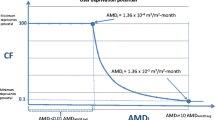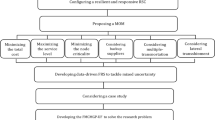Abstract
With increasing emphasis on ecological environment conservation, the conservation of fish habitat and the regional carbon balance need to be incorporated into the operation process of reservoirs. In this research, formulas for calculating ecological and environmental objectives in reservoir operation were obtained by fitting the curve of discharge and fish habitat area and comprehensively analysing the factors affecting reservoir carbon emissions. Additionally, we used the multi-objective optimization algorithm NSGA-II-DE to study the competitive relationship between the economic, ecological, and environmental benefits of the Longtoushi Reservoir and proposed a relatively optimized operation scheme using the multi-objective decision-making method VIKOR. The results of this scheme showed that the power generation, weighted usable area (WUA) and carbon emissions of Longtoushi Reservoir during the study period were 5.74 × 108 kW h, 9.61 × 104 m2 and 51.32 t, respectively. Compared with the relative optimal operation scheme, the power generated by the maximum power generation scheme increased by 2.66%, the WUA decreased by 1.68%, and carbon emissions increased by 9.86%; the power generation of the maximum WUA scheme increased by 0.16%, the WUA decreased by 0.08%, and carbon emissions increased by 0.72%; and the power generation of the minimum carbon emission scheme increased by 3.14%, the WUA decreased by 1.62%, and the carbon emissions increased by 9.14%. In general, competition between power generation, WUA and carbon emissions is inevitable, and reducing the water level in reservoirs can effectively increase ecological and environmental benefits.







Similar content being viewed by others
Data Availability
The datasets used and analysed during the current study are available from the corresponding author upon reasonable request.
References
Ahmad A, El-Shafie A, Razali SFM, Mohamad ZS (2014) Reservoir optimization in water resources: a review. Water Resour Manage 28:3391–3405
Bertsiou MM, Baltas E (2022) Energy, economic and environmental analysis of a hybrid power plant for electrification, and drinking and irrigation water supply. Environ Process 9
Chen L, Ge LS, Wang DW, Zhong WJ, Zhan T, Deng AJ (2022) Multi-objective water-sediment optimal operation of cascade reservoirs in the Yellow River Basin. J Hydrol 609
Deemer BR, Harrison JA, Li S, Beaulieu JJ, DelSontro T, Barros N, Bezerra-Neto JF, Powers SM, Dos Santos MA, Vonk JA (2016) Greenhouse gas emissions from reservoir water surfaces: a new global synthesis. Bioscience 66:949–964
DHI (2014) MIKE 21 & MIKE 3 FLOW MODEL FM, Hydrodynamic and Transport Module. Scientific Documentation. Danish Hydraulic Institute, Denmark.
Di D, Shi Q, Wu Z, Wang H (2022) Sustainable management and environmental protection for basin water allocation: differential game-based multiobjective programming. Water Resour Manage 37:1–20
Harrison JA, Prairie YT, Mercier‐Blais S, Soued C (2021) Year‐2020 global distribution and pathways of reservoir methane and carbon dioxide emissions according to the greenhouse gas from reservoirs (G‐res) model. Glob Biogeochem Cycles 35.
IPCC (2019) Refinement to the 2006 IPCC guidelines for national greenhouse gas inventories. Geneva. Switzerland. 4(7). https://www.ipcc-nggip.iges.or.jp/public/2019rf/index.html.
Labadie JW (2004) Optimal operation of multireservoir systems: State-of-the-art review. J Water Resour Plan Manag 130:93–111
Li YC, Qin Y, Yang Y, Li Z, Lu LH (2023) Estimation and analysis of carbon emissions from the large- and medium-sized reservoirs in the upper reaches of Changjiang River: On the basis of the IPCC National Greenhouse Gas Inventory. J Lake Sci 35(1). (In Chinese).
Li H, Zhang QF (2009) Multiobjective Optimization Problems With Complicated Pareto Sets, MOEA/D and NSGA-II. IEEE Trans Evol Comput 13:284–302
Li Y, Zhang GW (2018) Optimization Algorithm and Application of Hybrid NSGA-II and DE. Journal of Harbin University of Science and Technology 23(5):75–79 (In Chinese)
Liu WF, Zhu FL, Chen J, Wang H, Xu B, Song PB, Zhong PA, Lei XH, Wang C, Yan MJ, Li JY, Yang MZ (2019) Multi-objective optimization scheduling of wind–photovoltaic–hydropower systems considering riverine ecosystem. Energy Convers Manage 196:32–43
Ma ZQ, Wu GH, Suganthan PN, Song AJ, Luo QZ (2023) Performance assessment and exhaustive listing of 500+ nature-inspired metaheuristic algorithms. Swarm Evol Comput 77
Opricovic S (1998) Multicriteria optimization of civil engineering systems. Fac Civ Eng Belgrade 2:5–21
Opricovic S, Tzeng G-H (2004) Compromise solution by MCDM methods: A comparative analysis of VIKOR and TOPSIS. Eur J Oper Res 156:445–455
Prairie YT, Alm J, Beaulieu J, Barros N, Battin T, Cole J, Del Giorgio P, DelSontro T, Guerin F, Harby A, Harrison J, Mercier-Blais S, Serca D, Sobek S, Vachon D (2018) Greenhouse Gas Emissions from Freshwater Reservoirs: What Does the Atmosphere See? Ecosystems 21:1058–1071
Prairie YT, Mercier-Blais S, Harrison JA, Soued C, Giorgio PD, Harby A, Alm J, Chanudet V, Nahas R (2021) A new modelling framework to assess biogenic GHG emissions from reservoirs: The G-res tool. Environ Model Softw 143
Qin LL, Li KF, Li Y, Liang RF, Chen MQ, Hodges BR (2016) A habitat similarity model based on vague sets to assess Schizothorax prenanti spawning habitat. Ecol Eng 96:86–93
Qiu HY, Chen L, Zhou JZ, He ZZ, Zhang HS (2021) Risk analysis of water supply-hydropower generation-environment nexus in the cascade reservoir operation. J Clean Prod 283.
Rahimi H, Ardakani MK, Ahmadian M, Tang X (2019) Multi-reservoir utilization planning to optimize hydropower energy and flood control simultaneously. Environ Process 7:41–52
Rosa LP, Schaeffer R (1995) Global warming potentials - The case of emissions from dams. Energy Policy 23:149–158
Svensson B (2005) Greenhouse gas emissions from hydroelectric reservoirs: A global perspective. In Proceedings of international seminar on greenhouse fluxes from hydro reservoirs and workshop on modeling greenhouse gas emissions from reservoir at watershed level. Rio de Janeiro: Eletrobras, Coppe/Ufrj 25–37.
Tang CH, Yan QM, Li WD, Yang XY, Zhang SH (2022) Impact of dam construction on the spawning grounds of the four major Chinese carps in the Three Gorges Reservoir. J Hydrol 609
Wang PF, Shen YX, Wang C, Hou J, Qian J, Yu Y, Kong NE (2017) An improved habitat model to evaluate the impact of water conservancy projects on Chinese sturgeon ( Acipenser sinensis ) spawning sites in the Yangtze River, China. Ecol Eng 104:165–176
Wang XJ, Dong Z, Ai XS, Dong X, Li Y (2020) Multi-objective model and decision-making method for coordinating the ecological benefits of the Three Gorger Reservoir. J Clean Prod 270
Wasti A, Ray P, Wi S, Folch C, Ubierna M, Karki P (2022) Climate change and the hydropower sector: A global review. Wires Clim Change 13
Wen X, Lv YX, Liu ZH, Ding ZY, Lei XH, Tan QF, Sun YL (2021) Operation chart optimization of multi-hydropower system incorporating the long- and short-term fish habitat requirements. J Clean Prod 281.
Wu C, Liu P (2022) Prospects of reservoir operation for the goals of carbon peaking and carbon neutrality. J Water Resour Res 11:1–19
Xu W (2020) Study on multi-objective operation strategy for multi-reservoirs in small-scale watershed considering ecological flows. Water Resour Manage 34:4725–4738
Yang L, Lu F, Zhou XP, Wang XK, Duan XN, Sun BF (2014) Progress in the studies on the greenhouse gas emissions from reservoirs. Acta Ecol Sin 34:204–212
Yang L, Lu H, Yu XF, Li HP (2022) Carbon dioxide flux in the drained drawdown areas of Three Gorges Reservoir. Front Environ Sci 10
Yao WW, Liu HX, Chen YS, Zhang WY, Zhong Y, Fan HY, Li LK, Bamal S (2017) Simulating spawning and juvenile rainbow trout (oncorhynchus mykiss) habitat in colorado river based on high-flow effects. Water 9
Yao WW (2021) Ecohydraulic tools for aquatic fauna habitat and population status assessment, analysis and monitoring aimed at promoting integrated river management. Ecol Modell 456
Yi YJ, Cheng X, Yang ZF, Wieprecht S, Zhang SH, Wu YJ (2017) Evaluating the ecological influence of hydraulic projects: A review of aquatic habitat suitability models. Renew Sustain Energy Rev 68:748–762
Zeng Q, Hu P, Wang H, Pan J, Yang Z, Liu H (2019) The influence of cascade hydropower development on the hydrodynamic conditions impacting the reproductive process of fish with semi-buoyant eggs. Sci Total Environ 689:865–874
Zhang HX, Chang JX, Gao C, Wu HS, Wang YM, Lei KX, Long RH, Zhang LP (2019) Cascade hydropower plants operation considering comprehensive ecological water demands. Energy Convers Manage 180:119–133
Zhang JT, Dong ZC, Chen T (2020a) Multi-objective optimal allocation of water resources based on the NSGA-2 algorithm while considering intergenerational equity: a case study of the middle and upper reaches of huaihe river basin, China. Int J Environ Res Public Health 17
Zhang P, Qiao Y, Jin Y, Lek S, Yan TM, He Z, Chang JB, Cai L (2020b) Upstream migration of fishes downstream of an under-construction hydroelectric dam and implications for the operation of fish passage facilities. Glob Ecol Conserv 23
Acknowledgements
This work was supported by the National Natural Science Foundation of China [Grant No. U2240212] and the Science & Technology Fundamental Resources Investigation Program [Grant No. 2022FY100203].
Funding
National Natural Science Foundation of China, U2240212, Kefeng Li,Science & Technology Fundamental Resources Investigation Program, 2022FY100203, Kefeng Li
Author information
Authors and Affiliations
Contributions
Shiwei Yang: Conceptualization, Methodology, Software, Writing – original draft. Yuanqin Wei: Investigation, Data collection. Junguang Chen: Formal analysis. Yuanming Wang: Data curation. Ruifeng Liang: Project administration, Resources. Kefeng Li: Supervision, Funding acquisition.
Corresponding author
Ethics declarations
Competing Interest
The authors declare that they have no known competing financial interests or personal relationships that could have appeared to influence the work reported in this paper.
Additional information
Publisher's Note
Springer Nature remains neutral with regard to jurisdictional claims in published maps and institutional affiliations.
Rights and permissions
Springer Nature or its licensor (e.g. a society or other partner) holds exclusive rights to this article under a publishing agreement with the author(s) or other rightsholder(s); author self-archiving of the accepted manuscript version of this article is solely governed by the terms of such publishing agreement and applicable law.
About this article
Cite this article
Yang, S., Wei, Y., Chen, J. et al. Multi-Objective Optimization and Coordination of Power Generation, Ecological Needs, and Carbon Emissions in Reservoir Operation. Water Resour Manage 38, 123–136 (2024). https://doi.org/10.1007/s11269-023-03657-z
Received:
Accepted:
Published:
Issue Date:
DOI: https://doi.org/10.1007/s11269-023-03657-z




